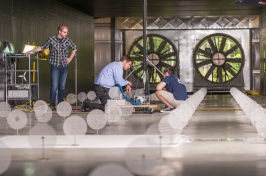The University of New Hampshire is a flagship research university that inspires innovation and transforms lives in our state, nation and world. More than 16,000 students from all 50 states and 71 countries engage with an award-winning faculty in top ranked programs in business, engineering, law, health and human services, liberal arts and the sciences across more than 200 programs of study. UNH’s research portfolio includes partnerships with NASA, NOAA, NSF and NIH, receiving more than $100 million in competitive external funding every year to further explore and define the frontiers of land, sea and space.
UNH Hosts NASA Space Apps Challenge April 29-30
DURHAM, N.H. -- The University of New Hampshire InterOperability Laboratory (UNH-IOL), an independent provider of broad-based testing and standards conformance services for the networking industry, and UNHInnovation (UNHI) will host the NASA Space Apps Challenge April 29-30, 2017, at 21 Madbury Road. This two-day event, considered one of the world's largest hackathons with events over 48 hours in more than 170 locations across six continents, is open to high school seniors, college students and young professionals.
People share ideas and engage with open data to address real-world problems on Earth and in outer space. This year’s theme is Earth science, supporting NASA’s missions to monitor Earth's vital signs from land, air and space. Challenges represent NASA mission priorities in human-environment interactions, global water cycles, natural disasters, ecological systems and the mysteries of the planet.
NASA helps shed light on Earth’s many components including oceans, terrains, and living things, collecting high-quality data covering all parts of the planet over time to learn more about the world we live in, and to predict the future processes on Earth.
This year participants are asked to develop mobile applications, software, hardware, data visualizations and platform solutions that could contribute to space exploration missions and help improve life on Earth. Participants gain experience using robotics, data visualization, hardware, design and more.
Participants will be judged on creativity, sustainability, and potential impact of their project upon Earth science. Based on their results, participants will have the option of moving onto the global level, where they will have the opportunity to win badges to see a NASA launch. Last year’s winners had front row seats to the OSIRIS-Rex asteroid mission launch.
The UNH-IOL has partnered with the NASA Space Apps Challenge for the past three years. The event invites engineers, coders, makers, artists and storytellers to connect over mission-related challenges. The growing Space Apps community represents the core of NASA's Open Innovation Initiative. Together, participants have developed thousands of open-source solutions.
NASA Space Apps Durham is hosted by Caleigh MacPherson ’12, ‘14G, a NASA Solar System Ambassador and the New Hampshire High Tech Council’s TechWoman of the Year.
To learn more, visit the NASA Space Apps Durham Page or follow the Space Apps’ Durham Twitter and Facebook pages.
The UNH-IOL is dedicated to being the world's premier data networking resource. Beginning in 1988, the UNH-IOL has built a multimillion dollar testbed and developed testing solutions to help companies efficiently and cost effectively deliver products to market. UNH-IOL’s services fit the needs of the market, while maintaining broad, comprehensive interoperability and conformance testing of networking, data, telecommunications, and storage products. The industry relies on UNH-IOL’s extensive staff experience, standards-bodies participation, 28,000+ square foot facility, and 100+ students who represent the future of interoperability testing and verification.
UNHInnovation (UNHI) advocates for, manages, and promotes UNH’s intellectual assets. UNHI strives to create partnerships between UNH and the business community and is responsible for commercializing UNH innovations and supporting university-based start-up companies.
Latest News
-
April 16, 2024
-
April 16, 2024
-
April 16, 2024
-
April 11, 2024
-
April 2, 2024

















































